2021 MERCEDES-BENZ GLS SUV belt
[x] Cancel search: beltPage 126 of 510
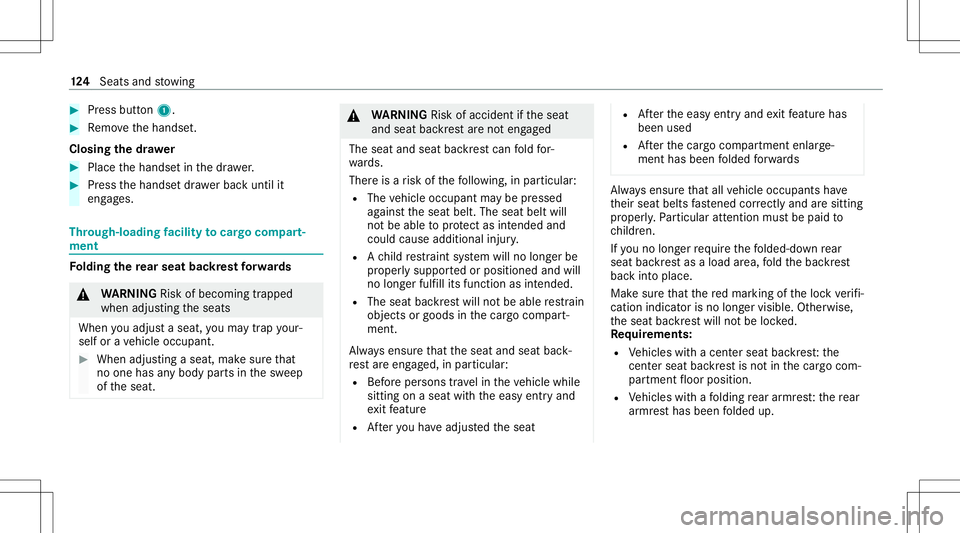
#
Press butt on1. #
Remo vethehandse t.
Closing thedr awe r #
Place thehandse tin thedr awe r. #
Press thehandse tdr awe rbac kuntil it
eng ages. Thr
ough-l oading facilit yto car gocom part‐
men t Fo
lding there ar seat backres tfo rw ards &
WARNIN GRisk ofbeco ming trap ped
whe nad jus ting theseats
When youadj usta seat ,yo uma ytrap your‐
self orave hicle occupant. #
When adjustingaseat, makesur eth at
no onehas anybody partsinthesw eep
of theseat. &
WARNIN GRisk ofacci dent ifth eseat
and seat backres tar eno teng aged
The seat andseat backres tcan fold for‐
wa rds.
Ther eis arisk ofthefo llo wing, inpar ticular :
R The vehicle occupant maybe pressed
ag ains tth eseat belt. Theseat beltwill
no tbe able toprotect asintended and
could cause additional injury.
R Ach ild restra int system will nolong erbe
pr oper lysuppor tedor position edand will
no long erfulf illits func tion asintended.
R The seat backres twill notbe able restra in
obje ctsor goods inthecar gocom part‐
ment .
Alw aysensur eth at theseat andseat back‐
re st areeng aged, inpar ticular :
R Beforeper son stra velin theve hicle while
sitting onaseat withth eeasy entryand
ex itfeatur e
R Afteryo uha ve adjus tedth eseat R
Afterth eeasy entryand exitfeatur ehas
been used
R Afterth ecar gocom partmen tenlar ge‐
ment hasbeen folded forw ards Alw
aysensur eth at all vehicle occupants have
th eir seat belts fastened correctly and aresitti ng
pr ope rly. Pa rticular attent ion mus tbe paid to
ch ildr en.
If yo uno longerre qu ire th efo lded-d ownre ar
seat backres tas aload area, fold thebac kres t
bac kint oplace.
Mak esur eth at there dmar kingof theloc kve rifi‐
cati onindi catorisno long ervis ible.Ot her wise,
th eseat backres twill notbe locked.
Re quirement s:
R Vehicles withacent erseat backres t:the
cent ersea tba ckrest isno tin thecar gocom‐
par tmen tfloor position.
R Vehicles withafo lding rear armr est:there ar
ar mr esthas been folded up. 12
4
Sea tsand stow ing
Page 127 of 510
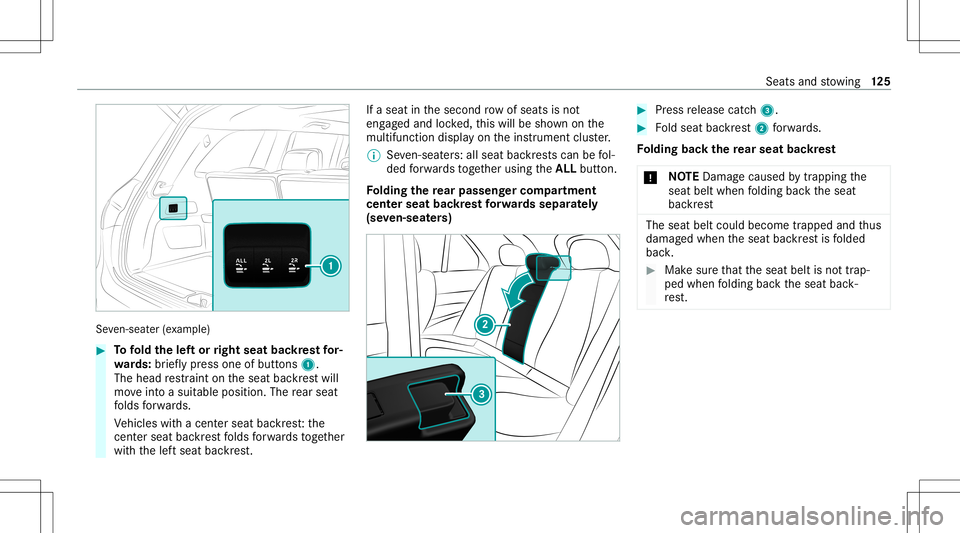
Se
ven-sea ter(e xa mp le) #
Tofold thelef tor right seat backres tfo r‐
wa rds: brief lypress one ofbutt ons 1.
The head restra int ontheseat backres twill
mo veintoasuit able posit ion.Therear seat
fo lds forw ards.
Ve hicles withacent erseat backres t:the
cent ersea tba ckrest folds forw ards toget her
wit hth elef tseat backres t. If
aseat inthesecon drow ofseats isno t
eng aged and locked, this will besho wnonthe
multifu nctiondisplay on theins trument cluster.
% Seven-sea ters:al lsea tba ckrestscan befol‐
ded forw ards toget her using theALL button.
Fo lding there ar passe nger comp artment
ce nter seat backres tfo rw ards separ ately
(se ven-seat ers) #
Press release catch3. #
Foldseat backres t2 forw ards.
Fo lding backth ere ar seat backres t
* NO
TEDama gecau sed bytrap ping the
seat beltwhen folding backth eseat
bac kres t The
seat beltcould become trapped andthus
damag edwhen theseat backres tis folded
bac k. #
Mak esur eth at theseat beltisno ttra p‐
ped when folding backth eseat back‐
re st. Sea
tsand stow ing 12
5
Page 133 of 510
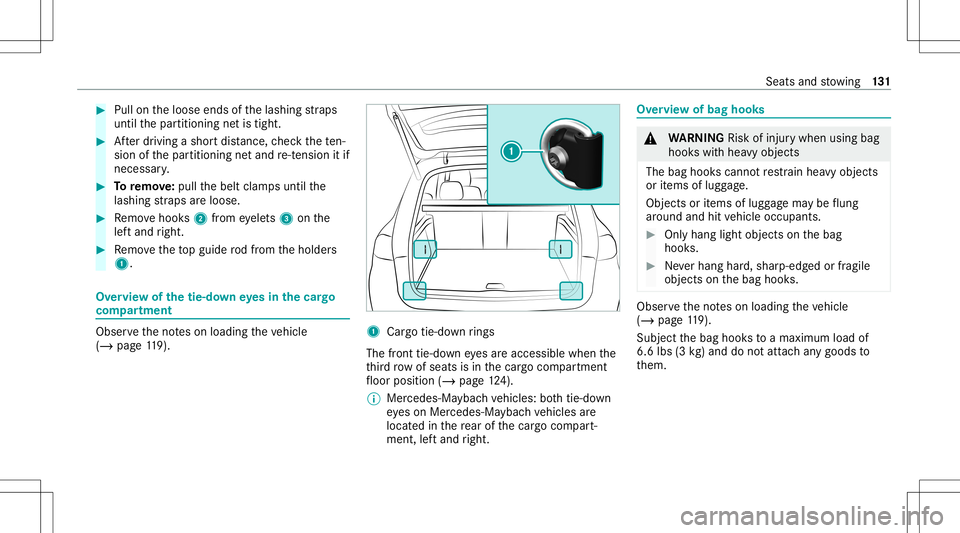
#
Pull ontheloose endsofthelashing stra ps
until thepar titioning netis tight . #
Afterdr iving ashor tdis tance, checkth ete n‐
si on ofthepar titioning netand re-tensi onitif
nece ssary. #
Toremo ve:pu llth ebelt clam psuntil the
lashin gst ra ps areloose. #
Remo vehook s2 from eyele ts3 onthe
lef tand right. #
Remo vetheto pguide rodfrom theholder s
1. Ov
ervie wof thetie- down eyes inthecar go
com partmen t Ob
serveth eno teson loadi ngtheve hicle
(/ page11 9). 1
Cargo tie-do wnrings
The front tie-do wn eyes areaccessible whenthe
th ird row ofseats isin thecar gocom partmen t
fl oor position (/page12 4).
% Mer cedes -Maybachvehicles: both tie-do wn
ey es on Mer cedes- Maybac hve hicles are
locat edinthere ar ofthecar gocom part‐
ment ,lef tand right. Ov
ervie wof bag hook s &
WARNIN GRisk ofinju rywhen usingbag
hook swit hhea vyobj ect s
The bag hook scan notre stra in hea vyobje cts
or items oflugg age.
Obj ectsor items oflugg agema ybe flung
ar oun dand hitvehicle occupants. #
Onlyhang lightobject son thebag
hook s. #
Neverhang hard,shar p-edg edorfragi le
objects onthebag hook s. Obser
vetheno teson loadi ngtheve hicle
(/ page11 9).
Subject thebag hook sto amax imum loadof
6. 6lbs (3kg)and donotatt achan ygoods to
th em. Seats
andstow ing 13
1
Page 157 of 510
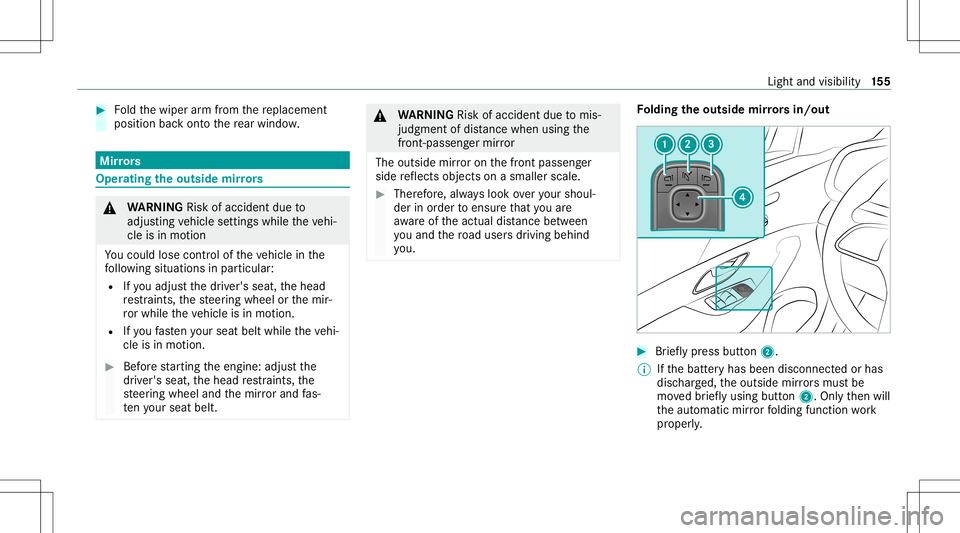
#
Foldthewiper arm from there placemen t
position backont oth ere ar wind ow. Mir
rors Oper
ating theout side mirrors &
WARNIN GRisk ofacci dent dueto
adjus tingve hicle settin gswhile theve hi‐
cle isin mo tion
Yo uco uld lose contro lof theve hicle inthe
fo llo wing situat ionsinpar ticular :
R Ifyo uadj ustth edr iver's seat, thehead
re stra int s,thesteer ing wheel orthemir‐
ro rwhi letheve hicle isin mo tion.
R Ifyo ufa sten your seat beltwhile theve hi‐
cle isin mo tion. #
Beforest ar tin gth eengine: adjustth e
dr iver's seat, thehead restra int s,the
st eer ing wheel andthemir rorand fas‐
te nyo ur seat belt. &
WARNIN GRisk ofacci dent dueto mis‐
judgment ofdis tance when using the
fr ont-passe nger mir ror
The outside mirroron thefront passeng er
side reflect sobjec tson asmaller scale. #
Ther efor e, alw ayslook over your sho ul‐
der inorder toensur eth at youar e
aw areof theactual distance betwee n
yo uand thero ad user sdr ivin gbehin d
yo u. Fo
lding theout side mirrors in/out #
Brief lypress butt on2.
% Ifth ebatt eryhas been discon nectedorhas
disc harged, theoutside mirrors mus tbe
mo vedbr ief lyusing button2. Onlyth en will
th eaut omatic mirrorfo lding function work
pr oper ly. Light
andvisib ility 15
5
Page 200 of 510

Electr
icpa rking brak e Electr
icpar king brak efunct ion(app lying
aut omat ically) &
WARNIN GRisk ofacci dent andinjury
due tochildr enleftunat tende din the
ve hicle
If ch ildr enarelef tunsuper visedintheve hi‐
cle, they cou ld,in pa rticular :
R Open doors,ther eb yendang ering other
per sons orroad user s.
R Getout and bestru ck byoncom ingtraf‐
fi c.
R Ope rate vehicle equipment andbecome
tr apped, forex am ple.
In addit ion,th ech ildr encould alsosetth e
ve hicle inmo tion, forex am ple by:
R Releasing thepar king brak e.
R Chang eth etransmission position.
R Startth eve hicle. #
Neverlea vechildr enunat tende din the
ve hicle. #
When leaving theve hicle, alwaysta ke
th eSmar tKey wit hyo uand lockth e
ve hicle. #
Keep theSmar tKey out ofreac hof chil‐
dr en. The
elect ric pa rking brak eis applied ifth etra ns‐
mission isin position 005Dand one ofthefo llo w‐
ing con dition sis fulf illed:
R The engin eis switc hedoff.
R The seat belttongu eis no tins ertedin the
seat beltbuckleofthedr iver's seat andthe
dr iver's door isopened.
R The transf ercase isin theLOW RANGEpos i‐
tion.
% Toprev ent application: pullthehandle ofthe
electr icpar king brak e.
In thefo llo wing situat ions,th eelectr icpar king
br ak eis also applied:
R ActiveDis tance AssistDIS TRONI Cis bring ing
th eve hicle toast ands till. R
The HOL Dfun ction iske eping theve hicle sta‐
tio nar y.
R ActivePa rking Assistis ke eping theve hicle
st atio nary.
This isthecase ifone ofthefo llo wing condition s
is also fulfilled:
R The engin eis switc hedoff.
R The seat belttongu eis no tins ertedin the
seat beltbuckleofthedr iver's seat andthe
dr iver's door isopened.
R Ther eis asy stem malfunct ion.
R The powe rsupp lyis insuf ficie nt.
R The vehicle isstatio naryfo ra lengt hyper iod.
When theelectr icpar king brak eis applied, the
re d0049 (USA)or0024 (Canada) indicatorlam p
appear sin theins trument cluster.
The electr icpar king brak eis no taut omaticall y
applied ifth eengine isswitc hedoffby theEC O
st ar t/ stop funct ion. 19
8
Driving and parking
Page 201 of 510
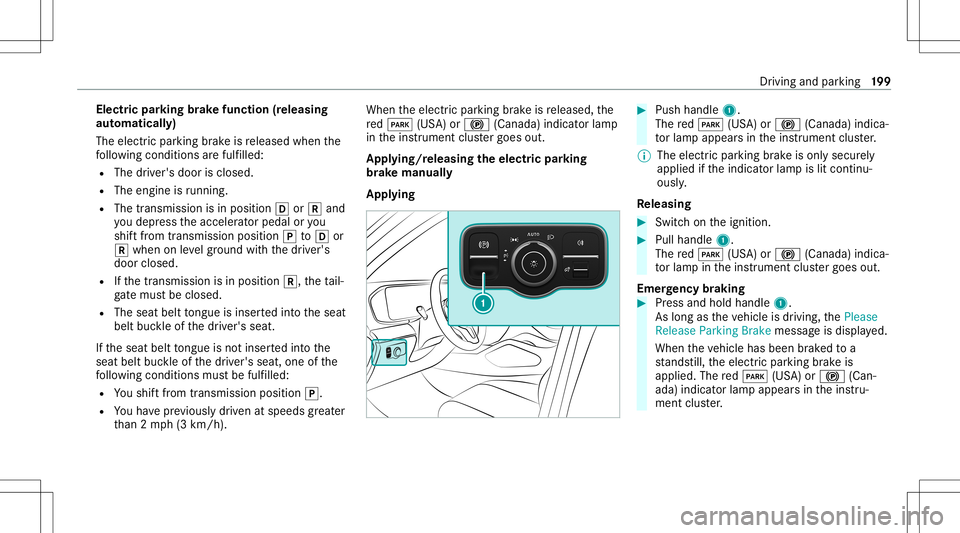
Electr
icpa rking brak efunct ion(releasing
aut omat ically)
The elect ric pa rking brak eis released whenthe
fo llo wing condition sar efulf illed:
R The driver's door isclos ed.
R The engin eis running .
R The trans mis sion isin po sitio n005B or005E and
yo udepr esstheaccelera torpeda lor you
shif tfr om transmission position005Dto005B or
005E when onleve lgr ou nd withth edr iver's
door closed.
R Ifth etra nsmiss ionisin position 005E,theta il‐
ga te mus tbe closed .
R The seat belttongu eis ins ertedint oth eseat
belt buckleofthedr iver's seat.
If th eseat belttongu eis no tins ertedint oth e
seat beltbuckleofthedr iver's seat, oneofthe
fo llo wing condition smus tbe fulf illed:
R Youshif tfr om transm issionposi tion005D.
R Youha ve prev iousl ydr iven atspeeds grea ter
th an 2mp h(3 km/h). When
theelectr icpar king brak eis released, the
re d0049 (USA)or0024 (Canada) indicatorlam p
in theins trument clustergoes out.
Appl ying/rele asing theelectr icpa rking
br ak ema nuall y
Appl ying #
Push handle 1.
The red0049 (USA)or0024 (Canada) indica‐
to rlam papp earsin theins trument cluster.
% The electr icpar king brak eis onl ysecur ely
applied ifth eindicat orlam pis lit con tinu‐
ously .
Re leasing #
Swit chon theignition . #
Pull handle 1.
The red0049 (USA)or0024 (Canada) indica‐
to rlam pin theins trument clustergoes out.
Emer gency braking #
Press and hold handle 1.
As long astheve hicle isdriving, thePlease
Release ParkingBrak emessag eis displa yed.
When theve hicle hasbeen brak ed toa
st ands till,th eelectr icpar king brak eis
applied. Thered0049 (USA)or0024 (Can‐
ada) indicat orlam pappear sin theins tru‐
ment cluster. Dr
iving and parking 19
9
Page 209 of 510
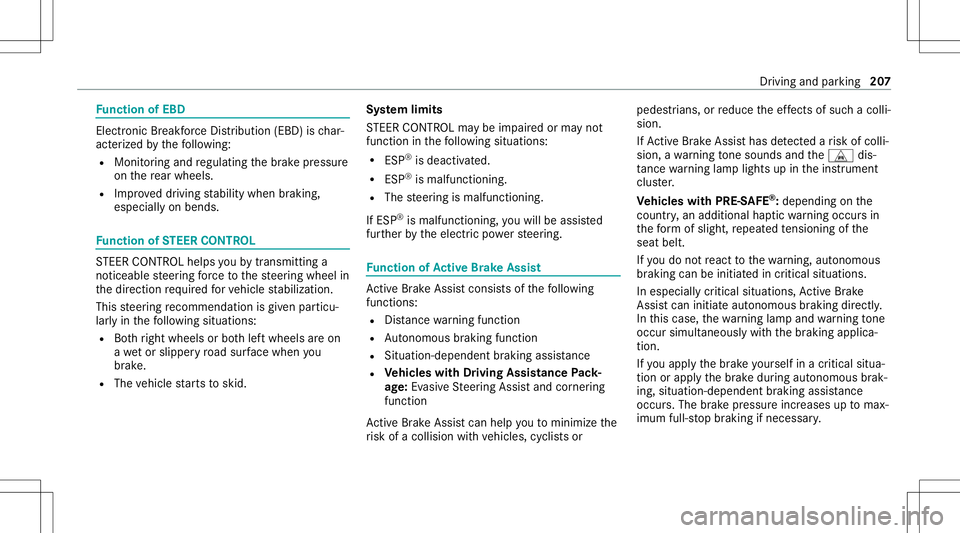
Fu
nction ofEBD Elect
ronic Brea kfor ce Dis trib uti on (EBD) isch ar‐
act erize dby thefo llo wing:
R Mon itor ing and regulating thebr ak epr essur e
on there ar wheels .
R Improv ed driving stabilit ywhen brakin g,
espe ciallyon ben ds. Fu
nction ofSTEER CONT ROL ST
EER CONTR OLhelpsyo uby trans mitting a
no tice ablesteer ing forc eto thesteer ing wheel in
th edir ect ion requ ired forve hicle stabiliz ation.
This steer ing recomme ndation isgiv en particu‐
lar lyin thefo llo wing situat ions:
R Both right wheels orboth leftwheels areon
a we tor slip pe ry road sur face whe nyo u
br ak e.
R The vehicle star ts to skid. Sy
stem limit s
ST EER CONTR OLmaybe impa ired orma yno t
fu nctio nin thefo llo wing situat ions:
R ESP®
is deact ivat ed.
R ESP®
is malfun ctionin g.
R The steer ing ismalfunct ioning.
If ES P®
is malfunct ioning,youwill beassis ted
fur ther by theelectr icpo we rst eer ing. Fu
nction ofActiv eBr ak eAs sist Ac
tiveBr ak eAssi stconsi stsof thefo llo wing
func tions:
R Distance warning func tion
R Autonomo usbraki ng func tion
R Situ ation-d epend ent braki ng assist anc e
R Vehicl eswith Drivin gAss istanc ePa ck‐
ag e:Evasi ve Steer ing Assis tand corner ing
func tion
Ac tiveBr ak eAssi stcan helpyo uto minimize the
ri sk ofacollision withve hicles, cyclis tsor pedes
trians, orreduce theef fects ofsuch acol li‐
sion .
If Ac tiveBr ak eAssi sthas detected arisk ofcolli‐
sion, awa rning tone sou nds and theL dis‐
ta nce warning lam plight sup intheins trument
clus ter.
Ve hicl eswith PRE-S AFE®
:depe nding onthe
cou ntry,an addit ionalhap ticwarning occursin
th efo rm ofslight, repeat edtensi oni ng ofthe
seat belt.
If yo udo notre act tothewa rning, autono mous
br akin gcan beinit iated incritic alsituat ions.
In espec iallycritic alsituat ions,Ac tiveBr ak e
Assi stcan initia te aut onomo usbrakin gdir ect ly.
In this case, thewa rning lam pand warning tone
occu rsi mu ltane ously with thebr aking applica‐
tion .
If yo uappl yth ebr ak eyo urself inacr itical situa‐
tio nor appl yth ebr ak edur ing autonomous brak‐
ing, situation -dependen tbr aking assistance
occu rs.The brak epr ess ureincr eases uptomax‐
imum full-sto pbr aking ifnec essar y. Dr
iving and parking 20
7
Page 210 of 510
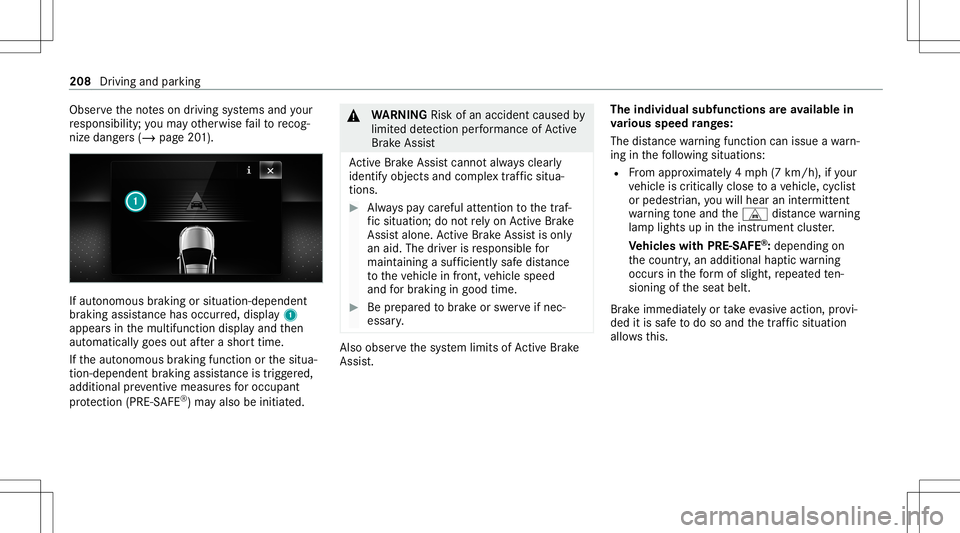
Obser
vetheno teson driving systems andyour
re sponsibili ty;yo uma yot her wise failto recog‐
nize dangers(/ page 201). If
au tonomo usbraki ng orsitua tion-de pende nt
br aki ng assist anc ehas occurred, displa y1
appear sin themultifunc tiondispla yand then
aut omaticall ygoes outafte ra shor ttime.
If th eaut onomous braking function orthesitua‐
tion -dependen tbr aking assistance istrig ge red,
additional preve ntiv emea suresfo roccupa nt
pr otect ion (PRE-S AFE®
)ma yalso beinitiat ed. &
WARNIN GRisk ofan acci dent caused by
limit eddetection perform anc eof Active
Br ak eAssi st
Ac tiveBr ak eAssi stcanno tal wa ys cle arly
ident ifyobje ctsand complextraf fic situ a‐
tions . #
Alw ayspa ycar eful attention tothetra f‐
fi c situ ation; donotre ly on ActiveBr ak e
Assi stalon e.Ac tiveBr ak eAssi stisonl y
an aid. Thedriver isresponsible for
maint ainingasuf ficie ntly safedist anc e
to theve hicle infront, vehicle speed
and forbr aking ingood time. #
Beprepa redto brak eor sw erve ifnec ‐
essar y. Als
oob ser vethesy stem limits ofActiveBr ak e
Assi st. The
indiv idua lsub func tions areav ailab lein
va rious speed rang es:
The distance warning func tion canissue awa rn‐
ing inthefo llo wing situat ions:
R From appr oximat ely4 mp h(7 km/h), ifyo ur
ve hicle iscritically closetoave hicle, cyclis t
or pedes trian, youwill hear anintermit tent
wa rning tone and theL distance warning
lam plight sup intheins trument cluster.
Ve hicl eswith PRE-S AFE®
:depe nding on
th ecount ry,an addition alhap ticwarning
occ ursin thefo rm ofslight, repeat edten‐
si oni ng oftheseat belt.
Br ak eimmediat elyortake evasiv eact ion,pr ov i‐
ded itis saf eto do soand thetraf fic situ ation
al lo ws this. 208
Drivin gand parking